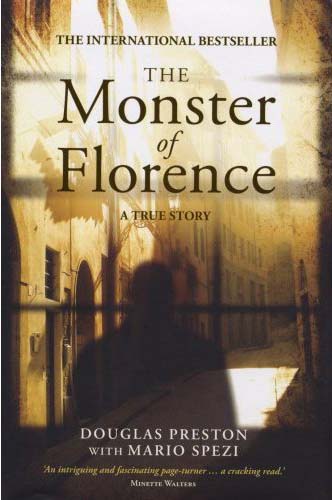
EURO CRIME
Reviews

Preston, Douglas with Spezi, Mario - 'The Monster of Florence'
Hardback: 336 pages (Jan. 2009) Publisher: Virgin Books ISBN: 1905264674
Real-life crime stories can be stranger than fiction, and that is certainly the case here. Douglas Preston usually writes the latter kind of story, sometimes co-writing with Lincoln Child. In fact, this book began when Douglas moved to Florence to research the background to a crime novel that he was planning to write, when he met Mario Spezi, a journalist on the local newspaper, and discovered the history of the 'Monster of Florence'. Spezi himself only came across one of the early murders by accident in 1981, when he agreed to cover the crime desk on what he though would be a slow Sunday. He began to wonder if he was missing something important, so he drove to the police headquarters to check. Consequently, he was the first journalist to find out that a couple had been found murdered in their car in the peaceful Tuscan countryside. Over the next four years, there were four more murders, each with a very similar modus operandi. The Monster of Florence killed fourteen people (7 couples) in total, but was never caught and even now his identity is still uncertain.
The first part of the book covers the murder investigations chronologically as Mario Spezi covered them for his newspaper and became an expert on the Monster of Florence. It relates how the police and justice system investigated the murders, their ineptitude, their frustration at the lack of evidence and their own political agendas. Various people were arrested, convicted and then eventually released when other murders were committed whilst they were in jail. In complete contrast to fictional crime novels, the crime scenes are often badly contaminated and there is no insightful forensic specialist who can decipher clues left at the scene, or draw conclusions from examining the bodies. Eventually, perhaps in sheer desperation, the police start to believe ramblings published on a conspiracy website by a Roman woman named Gabriella Carlizzi who claims that the murders were committed by a satanic sect.
Towards the end of the book, the authors describe how Mario Spezi was arrested and imprisoned, and all of his research material was taken away for examination shortly before Spezi and Preston were due to publish their joint book on the Monster of Florence. Bizarrely, Spezi was accused of being the mastermind behind the crimes himself, but had to be released when it was clear there was no evidence. Even Douglas Preston is formally named as an official suspect of a crime related to the murders. Eventually, the chief investigator in the case, Michele Giuttari is arrested for fabricating evidence, though later acquitted. However, he and the judge involved are still likely to face charges of abuse of office and other crimes.
There is a vast cast of characters involved in the investigations into the Monster of Florence, and a whole wealth of theories about who the Monster might be. The authors gradually reveal the story, the possibilities and the twists and turns in the investigations in an engaging style. What works particularly well is the insight given into how the police and the judiciary investigate the murders, and the way in which the justice system appears to work (or not!) in Italy. Preston comments towards the end of the book that a good crime novel should have a killer with a comprehensible motive, a trail of evidence and a process of discovery that leads to the truth, and that he and Spezi made the 'fatal' mistake in assuming the Monster of Florence case would follow this pattern. Despite this, THE MONSTER OF FLORENCE is a fascinating read.
(The official website for the book is at http://www.monsterofflorence.co.uk/.)
Michelle Peckham, England
January 2009
More European crime fiction reviews can be found on the Reviews page.